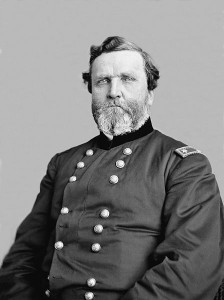Civil War Quiz – The Battles for Atlanta
Q#1 – What was the nickname the City of Atlanta gave itself during the middle of the 19th Century?
Q#2 – When Union general William T. Sherman began his Atlanta Campaign in May 1864, what was the name of the commanding general of the Confederate forces?
Q#3 – General Sherman’s Military Division of the Mississippi consisted of three large armies; what were their names?
Q#4 – In the spring of 1864, what shocking proposal did General Patrick Cleburne submit to increase the number of soldiers in the Confederate Army of Tennessee?
Q#5 – What tactic did Union general Sherman employ during the early stages of the campaign to avoid a frontal confrontation with the Confederate force?
Q#6 – What were the conflicting reasons that on May 19, 1864, Confederate general Johnston retreated instead of going forward with an attack at Cassville, Georgia?
Q#7 – During the last week of May 1864, three major engagements were fought continuously during that period: New Hope Church, Pickett’s Mill, and Dallas, Georgia. What name did the Union troops give to this series of battles?
Q#8 – At the June 27, 1864, Battle of Kennesaw Mountain, which resulted in a minor victory for the Confederacy, what attack tactic did Union general Sherman employ that he would never use again during the remainder of the war?
Q#9 – In July 1864, Confederate President Jefferson Davis sent what general to Atlanta to determine if General Joseph E. Johnston was planning to defend Atlanta or abandon it?
Q#10 – On July 17, 1864, what was the name of the Confederate general who replaced Joseph E. Johnston?
Q#11 – What was the name of the battle fought on July 20, 1864, which marked the first battle of the Confederate Army of Tennessee under its new commander?
Q#12 – What was the name of the only commander of a Federal army to die in the Civil War?
Q#13 – What was the name of the highest ranking Union prisoner of war who was captured in July 1864 attempting to free the Union prisoners at the Confederate Andersonville prison?
Q#14 – What was the reason Union general Sherman authorized a bombardment of the City of Atlanta beginning on August 9, 1864?
Q#15 – What were the contents of the telegram sent by Union general Sherman to his superiors in Washington after the surrender of Atlanta on September 2, 1864?

